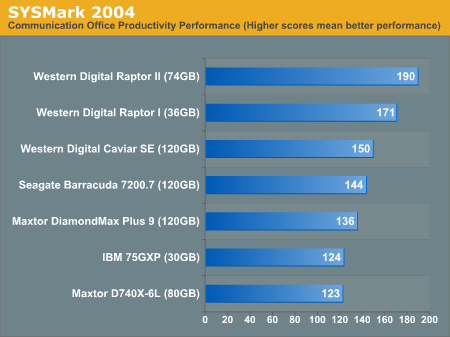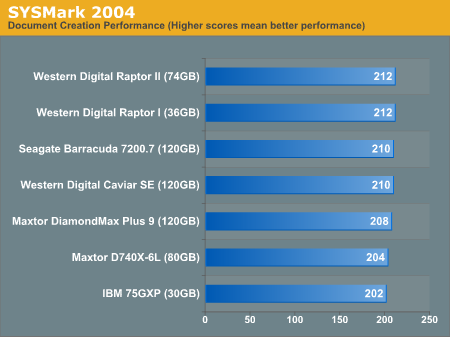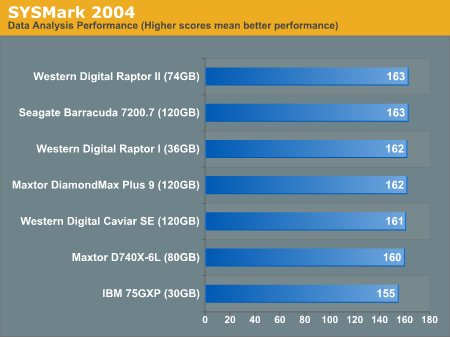Q2 2004 Desktop Hard Drive Comparison: WD Raptor vs the World
by Anand Lal Shimpi on June 7, 2004 12:05 AM EST- Posted in
- Storage
Overall System Performance - SYSMark (continued)
SYSMark's Office Productivity suite consists of three tests, the first of which is the Communication test. The Communication test consists of the following:
"The user receives an email in Outlook 2002 that contains a collection of documents in a zip file. The user reviews his email and updates his calendar while VirusScan 7.0 scans the system. The corporate web site is viewed in Internet Explorer 6.0. Finally, Internet Explorer is used to look at samples of the web pages and documents created during the scenario."

The Communication test tends to be very disk dependent and thus, we see significant differences between the drives. The advantage of a larger cache is evident, as the newer 7200RPM drives hold at least a 10% performance advantage over the older drives.
This test also shows a significant performance advantage for the Raptors. This is the first test in our suite that shows a substantial difference between the first and second generation Raptors, with the new Raptor outpacing the old one by 11%. The new Raptor also manages to offer a 27% performance advantage over the fastest 7200RPM drive in this comparison. What is very important about this advantage is that it is a 27% advantage, not in a disk only test, but in a real world test. Any situation where a drive is able to increase overall system performance by 27% is one that demands attention, especially if it isn't an unusual situation; in this case, it very much isn't.
The next test is Document Creation performance, which shows very little difference in drive performance between the contenders:
"The user edits the document using Word 2002. He transcribes an audio file into a document using Dragon NaturallySpeaking 6. Once the document has all the necessary pieces in place, the user changes it into a portable format for easy and secure distribution using Acrobat 5.0.5. The user creates a marketing presentation in PowerPoint 2002 and adds elements to a slide show template."

The biggest difference here is less than 5%, so there's not too much to talk about. The drives' impact on performance is basically negligible.
The final test in our Office Productivity suite is Data Analysis, which BAPCo describes as:
"The user opens a database using Access 2002 and runs some queries. A collection of documents are archived using WinZip 8.1. The queries' results are imported into a spreadsheet using Excel 2002 and are used to generate graphical charts."

Although you would think that Data Analysis would show significant differences in drive performance, this particular test still isn't as disk bound as the Communication test. The performance spread here is 5%.










50 Comments
View All Comments
T8000 - Monday, June 7, 2004 - link
One point I did not see in the review was the partition information.This may be important, because smaller partitions usually perform better, because of their smaller allocation table and possibly even a smaller cluster size.
It would be best to use a drive image that fits on all drives and load it on each drive for testing, to make sure smaller drives are not given an advantage over bigger drives and fragmentation is the same for all drives.
Did you use this method?
broberts - Monday, June 7, 2004 - link
It would be nice if you included the actual model numbers of the tested drives.Perhaps I'm missing something but ISTM that comparing benchmarks of SATA drives against those running at PATA-100 is questionable. Especially since most of the numbers reported are within 5% of each other. Why weren't SATA models of the 8MB/7200 drives used?
jrphoenix - Monday, June 7, 2004 - link
I have submitted my request to Anand. I would like to see the new Seagate and Hitachi drives. The new 7200 rpm Seagates (shipping this month) support NCQ and are supposedly quicker than the raptors at a lower price!!! :)Crassus - Monday, June 7, 2004 - link
Anand,I would have liked to see also the performance of 2 Raptors of both generations in RAID 0, at least with the integrated controllers (ICH5 etc.).
Nighteye2 - Monday, June 7, 2004 - link
It's good to see this test, but why are the raptors the only SATA drives? It would be good to add in a SATA WD 7200 RPM 8 MB drive (80 GB, 120 GB, or another size)trexpesto - Monday, June 7, 2004 - link
Since with buying technology part of the equation is how long to hold off, it would be cool to get a head's up on stuff in the pipeline like the NCQ/TCQ drives.http://www.seagate.com/cda/newsinfo/newsroom/relea...
Apologiliac - Monday, June 7, 2004 - link
I was startled how quiet the seagate was, because i was wating for it to turn on (?...!) I was also laughing out loud after the new raptor played because it immediately followed by gangsters paradise by weird al on my playlist :pdeathwalker - Monday, June 7, 2004 - link
I am somewhat dissapointed that this review did not include at least a couple of competing SATA drives...such as maybe a Seagate and Maxtor drive. The majority of the community already assumes the advantages of SATA over PATA!!Blain - Monday, June 7, 2004 - link
A 75GXP? You gotta be kiddin'Why not run the other drives against a new Hitachi?
For crying out loud! :o
Z80 - Monday, June 7, 2004 - link
Your review was right on target for my needs. I was considering upgrading my 120GB Maxtor to a new WD 74GB Raptor. Looks like I can save my money now or spend it on an upgrade that gives more bang for the buck. Thanks